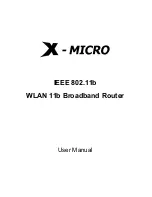
1-15
To do…
Use the command…
Remarks
Specify the authentication method
for LAN users
authentication lan-access
{
local
|
none
|
radius-scheme
radius-scheme-name
[
local
] }
Optional
The default authentication method
is used by default.
Specify the authentication method
for login users
authentication login
{
hwtacacs-scheme
hwtacacs-scheme-name
[
local
] |
local
|
none
|
radius-scheme
radius-scheme-name
[
local
] }
Optional
The default authentication method
is used by default.
z
The authentication method specified with the
authentication default
command is for all types of
users and has a priority lower than that for a specific access mode.
z
With an authentication method that references a RADIUS scheme, AAA accepts only the
authentication result from the RADIUS server. The Access-Accept message from the RADIUS
server does include the authorization information, but the authentication process ignores the
information.
z
With the
radius-scheme
radius-scheme-name
local
or
hwtacacs-scheme
hwtacacs-scheme-name local
keyword and argument combination configured, local
authentication is the backup method and is used only when the remote server is not available.
z
If the primary authentication method is
local
or
none
, the system performs local authentication or
does not perform any authentication, and will not use any RADIUS or HWTACACS authentication
scheme.
Configuring AAA Authorization Methods for an ISP Domain
In AAA, authorization is a separate process at the same level as authentication and accounting. Its
responsibility is to send authorization requests to the specified authorization server and to send
authorization information to users. Authorization method configuration is optional in AAA configuration.
AAA supports the following authorization methods:
z
No authorization: Every user is trusted and has the corresponding default rights of the system.
z
Local authorization: Users are authorized by the access device according to the attributes
configured for them.
z
Remote authorization: The access device cooperates with a RADIUS or HWTACACS server to
authorize users. RADIUS authorization is bound with RADIUS authentication. RADIUS
authorization can work only after RADIUS authentication is successful, and the authorization
information is carried in the Access-Accept message. HWTACACS authorization is separate from
HWTACACS authentication, and the authorization information is carried in the authorization
response after successful authentication. You can configure local authorization or no authorization
as the backup method in case the remote server is not available.
By default, an ISP domain uses the local authorization method. If the no authorization method (
none
) is
configured, the users are not required to be authorized, in which case an authenticated user has the
default right. The default right is visiting (the lowest one) for EXEC users (that is, console users who use
the console, AUX port, or Telnet to connect to the device, such as Telnet or SSH users. Each connection
















































